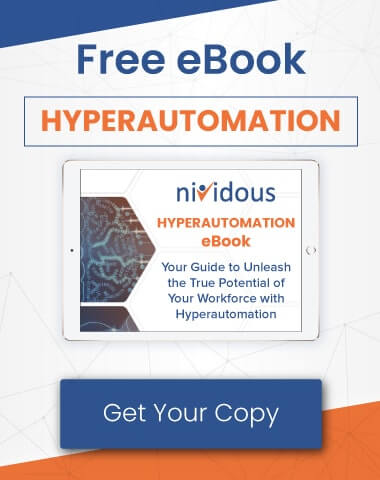As new automation technologies continue to emerge, machines are armed to perform more, faster, and better than humans.
Hyperautomation is expected to enable both services and asset-intensive enterprises to gain 20% to 30%, or more, in operational efficiencies over the next 10 years, as per leading industry analyst firm Gartner in its recent report “A Counterintuitive Way to Preempt Resistance to Hyperautomation: Promote the Plans.”
Nevertheless, the report also underlines, “70% of digitalization projects fail in developing countries, often due to worker resistance,”
Hyperautomation efforts are often misunderstood because of the possibility of displacing workers. This typically stems from poor communication with workers about the benefits of automation initiatives to the company and the workers.
What is Hyperautomation?
Before we deep dive into how to prevent the resistance to Hyperautomation from workers, let us better understand Hyperautomation and its use for businesses.
|
Hyperautomation is the use of digital technologies to automate activities to achieve a step-change improvement in business performance. |
The term “Hyperautomation” was coined by Gartner as one of the year’s top 10 strategic technology trends. Hyperautomation, a more disciplined approach towards business results, allows you to combine complementary technologies such as Robotic Process Automation (RPA), Artificial Intelligence (AI), Machine Learning (ML), Business Process Management (BPM), process mining, and other types of decision and task automation tools to automate more processes end-to-end. With Hyperautomation, you can automate more and more tasks at higher speed and often at scale, achieving even more value that has a lasting impact on the overall business.
Want to learn more about Hyperautomation?
Watch the on-demand webinar about hyperautomation and its benefits.
Why stakeholders resist adopting Hyperautomation
Early adopters of process automation technologies have already realized tremendous benefits, including quick return on investment (RoI), improved process turnaround time, and a significant reduction in human errors. Yet, many organizations face resistance from internal and external stakeholders. Some of the observed reasons behind this resistance are
- People, including some senior business executives, feel threatened by automation
- They are intimidated and they do not know how to use the new technology
- They don’t see the value of new automation technologies for the company or their work
- They are not guided with a proper context for the technologies
- and many more
Additionally, there are several myths and misinformation around process automation technologies that add to the resistance. Automation has become a necessity for businesses to survive and compete and hence it is important to find ways to overcome the challenges faced in getting buy-in from key stakeholders.
Deep-dive into 4 ways to preempt workforce resistance to Hyperautomation
Gartner, in its report*, suggests executive leaders guiding digital transformation should:
- “Propose a long-range automation plan that makes provisions for personnel.
- Consider automation from various stakeholders’ perspectives.
- Improve the factors that affect technology acceptance.
- Develop a potential life cycle for jobs in the path of hyperautomation.”
*Gartner, A Counterintuitive Way to Preempt Resistance to Hyperautomation: Promote the Plans, 17 February 2021, Dale Kutnick, Christie Struckman, Mary Mesaglio
1. Building a long-range five-year roadmap for Hyperautomation
Do not hide your automation plans or unveil them just before the final roll-out of a phased deployment. This approach will increase the uncertainties and fuel greater resistance over time. Instead, build a long-term three-to-five-year roadmap for your new automation initiatives giving enough time for workers and business leaders to prepare.
While planning, enterprises should pay close attention to several aspects, including what level of automation they need. Do they need to eliminate human reliance, or do they need to augment humans using AI to enhance their performance? What is the expected RoI? Will automation drive innovation and process improvement across the organization over 5 years? Which is a good approach – bottom-up or top-down? What are the contingencies that can be avoided? Be as specific as you can to map out your automation goals.
2. Why does workers’ perspective in designing an automation project matter?
Automation projects are not merely technology projects. They need cohesive planning involving all stakeholders from business and functional units to receive an overall acceptance. Your stakeholders are not just executive leaders but workers, customers, users, and business partners as well. All of these perspectives are important for a successful and sustainable roll-out of your automation projects.
3. What are the factors that affect technology acceptance?
According to Gartner, “Any automation — even full automation — depends on how people receive and exploit it. Humans must be able to exploit the technology properly to improve productivity or achieve other outcomes. Executive leaders can increase the chances that hyperautomation succeeds by addressing the factors that contribute to its acceptance”:
- Automation: how easy and effective is the automation technology?
- Uncertainty avoidance: address the anxiety of accepting the change.
- Preparation: check the readiness of the users/people using the technology.
4. How to develop a potential life cycle for jobs?
It is vital to mitigate the anxiety of workers who fear losing jobs to automation tools. They also fear that once laid off, they will not find good replacement jobs. Business leaders should let workers know well ahead of time which jobs are at risk or require new skill sets. They should develop and execute timely training programs to help workers acquire new skills that will keep them relevant for future work. Enterprises may also need to create some temporary roles to effectively execute automation plans and should build estimated life cycles for each role or job affected by automation.
Getting started with Hyperautomation
Starting your Hyperautomation journey does not require a complete revamp of your entire digital ecosystem. You can start small by automating simple, rules-based business processes using RPA. Robotic process automation is fast – you can even start with a single RPA bot that is inexpensive, and has a return on investment (ROI) that is very easy to measure in most implementations. That makes it a great way to win internal support for broader Hyperautomation goals; prove an ROI for a single task, and you will achieve buy-in for more automation.
To discuss how the Nividous Hyperautomation platform can help you begin your automation journey and solve your business challenges, contact us today—or click here to keep reading about hyperautomation.




![The Path Forward for Intelligent Automation [2024 Trends] Blog Feature](https://nividous.com/wp-content/uploads/2024/05/The-Path-Forward-for-Intelligent-Automation-blog-feature-1.webp)
